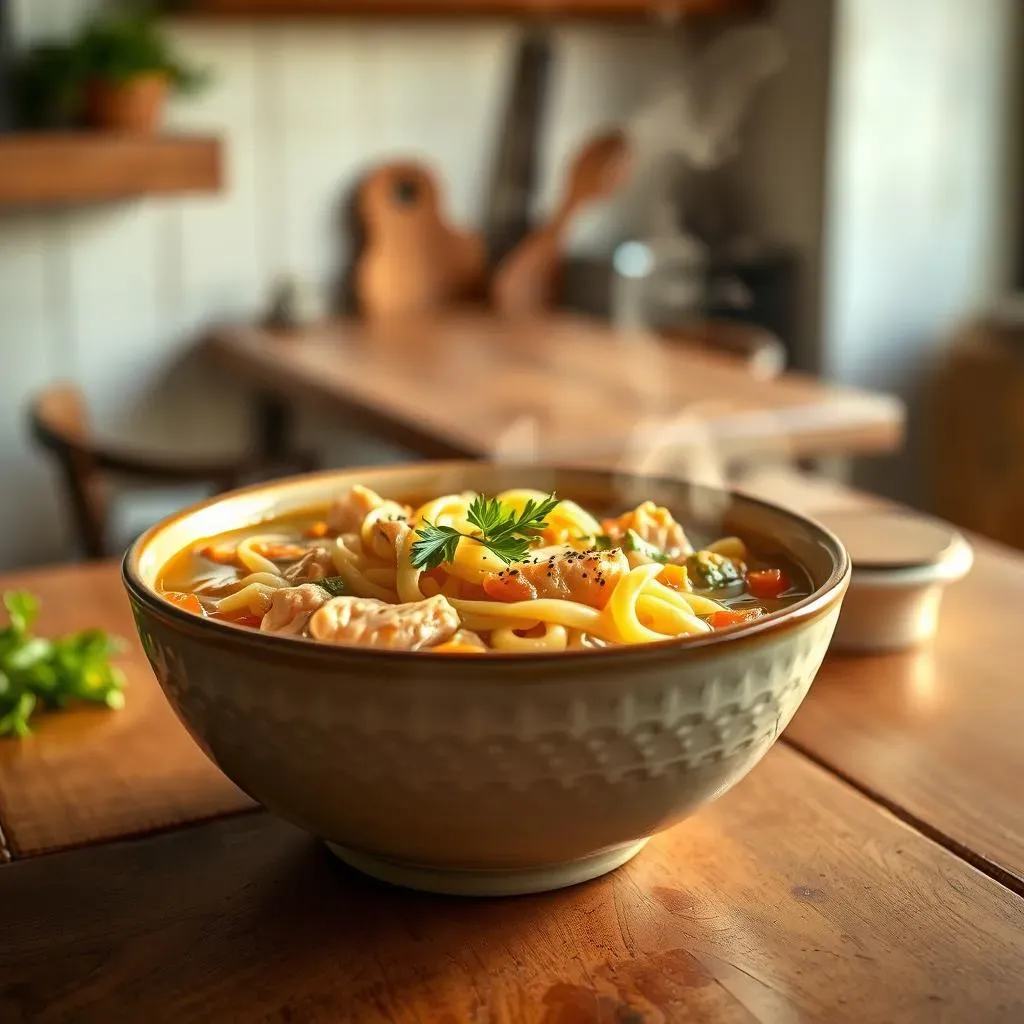Table of Contents
Few dishes evoke the warmth and comfort of a homemade bowl of soup, and at the top of that list sits the classic chicken noodle soup recipe. It's more than just a meal; it's a hug in a bowl, a remedy for whatever ails you, and a nostalgic trip back to childhood. This isn't your average canned soup – we're talking about a rich, flavorful broth brimming with tender chicken, perfectly cooked noodles, and vibrant vegetables. Whether you're a seasoned cook or just starting out, this guide will walk you through creating the ultimate classic chicken noodle soup from scratch.
The Heart of Classic Chicken Noodle Soup: Ingredients You'll Need
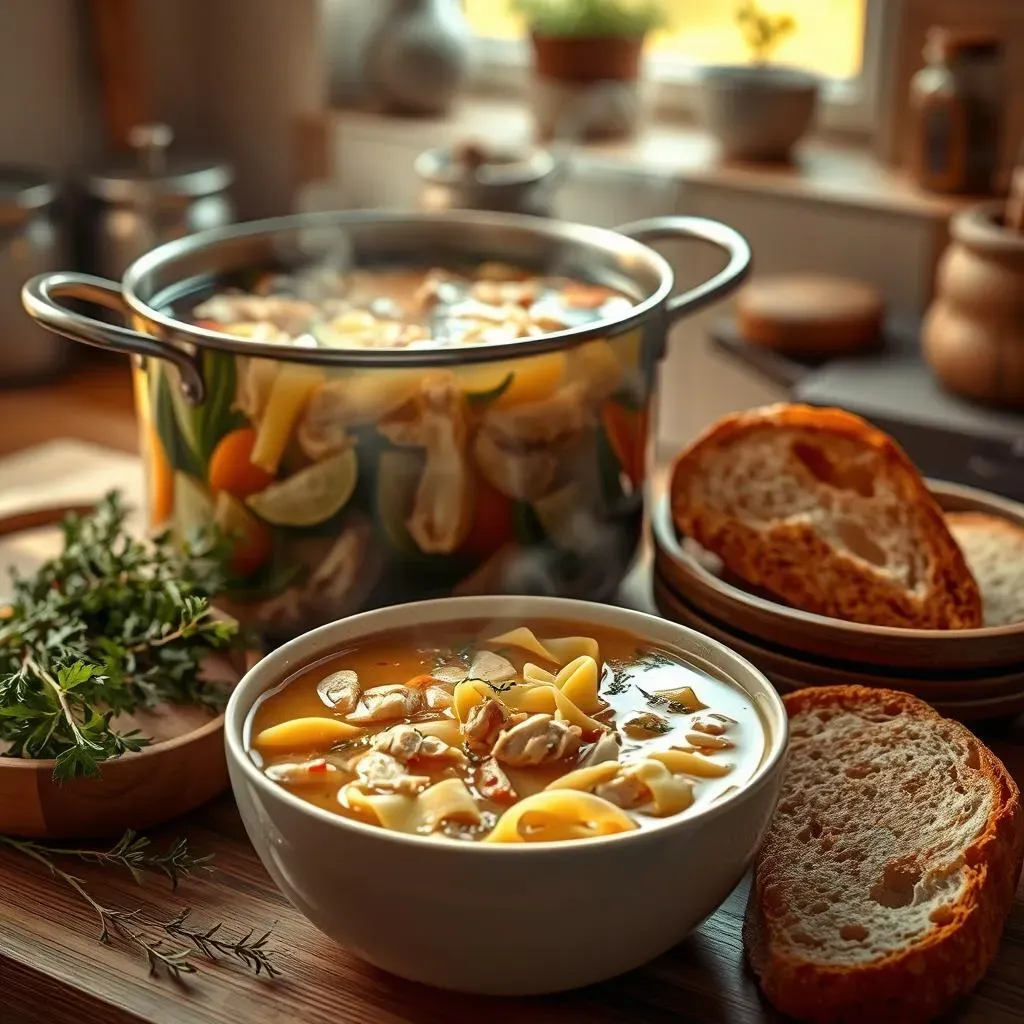
The Heart of Classic Chicken Noodle Soup: Ingredients You'll Need
The Broth Foundation
Let's talk broth, because honestly, it's where the magic happens. You could grab a carton from the store, and that's fine in a pinch, but if you want that truly soul-satisfying flavor, homemade is the way to go. Don't freak out – it's easier than you think! I usually use a rotisserie chicken carcass for convenience. Just toss it in a big pot with some onion, carrots, celery, garlic, bay leaves, and peppercorns, cover it with water, and let it simmer for a few hours. The longer it simmers, the richer the flavor. Seriously, this is where the depth of your soup comes from.
Now, if you're short on time, a good quality store-bought chicken broth will work. Just be sure to choose one that's low in sodium so you can control the saltiness of the final soup. And if you're feeling adventurous, you can even make your own broth from scratch using chicken thighs or a whole chicken. The possibilities are endless!
The Veggie Powerhouse
Next up: vegetables! The classic trio of onion, carrots, and celery is a must. They create a beautiful aromatic base that complements the chicken perfectly. I like to dice them fairly small so they cook evenly and become tender in the soup. But don't stop there! Feel free to add other veggies you love, like parsnips, leeks, or even a little bit of chopped bell pepper for a touch of sweetness.
Fresh herbs are also key. Parsley and thyme are my go-to choices, but rosemary, oregano, or even a bay leaf can add a lovely depth of flavor. Just remember to remove the bay leaf before serving! I usually add the herbs towards the end of cooking to preserve their freshness and aroma.
Ingredient | Why It's Important |
|---|---|
Onion, Carrots, Celery | Aromatic base for flavor |
Fresh Herbs (Parsley, Thyme) | Adds freshness and complexity |
Garlic | Adds pungent flavor |
The Chicken & Noodle Finale
Of course, we can't forget the chicken and noodles! For the chicken, I like to use shredded meat from the rotisserie chicken I used to make the broth. It's already cooked and full of flavor, which saves time and effort. You can also use leftover cooked chicken or poach chicken breasts specifically for the soup.
Now, for the noodles... this is where things get interesting. Homemade egg noodles are the gold standard, and they're surprisingly easy to make. But if you're not up for making them from scratch, store-bought egg noodles are perfectly fine. Just be sure to choose a good quality brand that won't turn to mush in the soup. I also like to use other types of noodles, like wide noodles, or even gluten-free noodles if needed. The key is to cook the noodles separately from the soup to avoid them absorbing too much broth and becoming soggy.
StepbyStep: Crafting Your Classic Chicken Noodle Soup
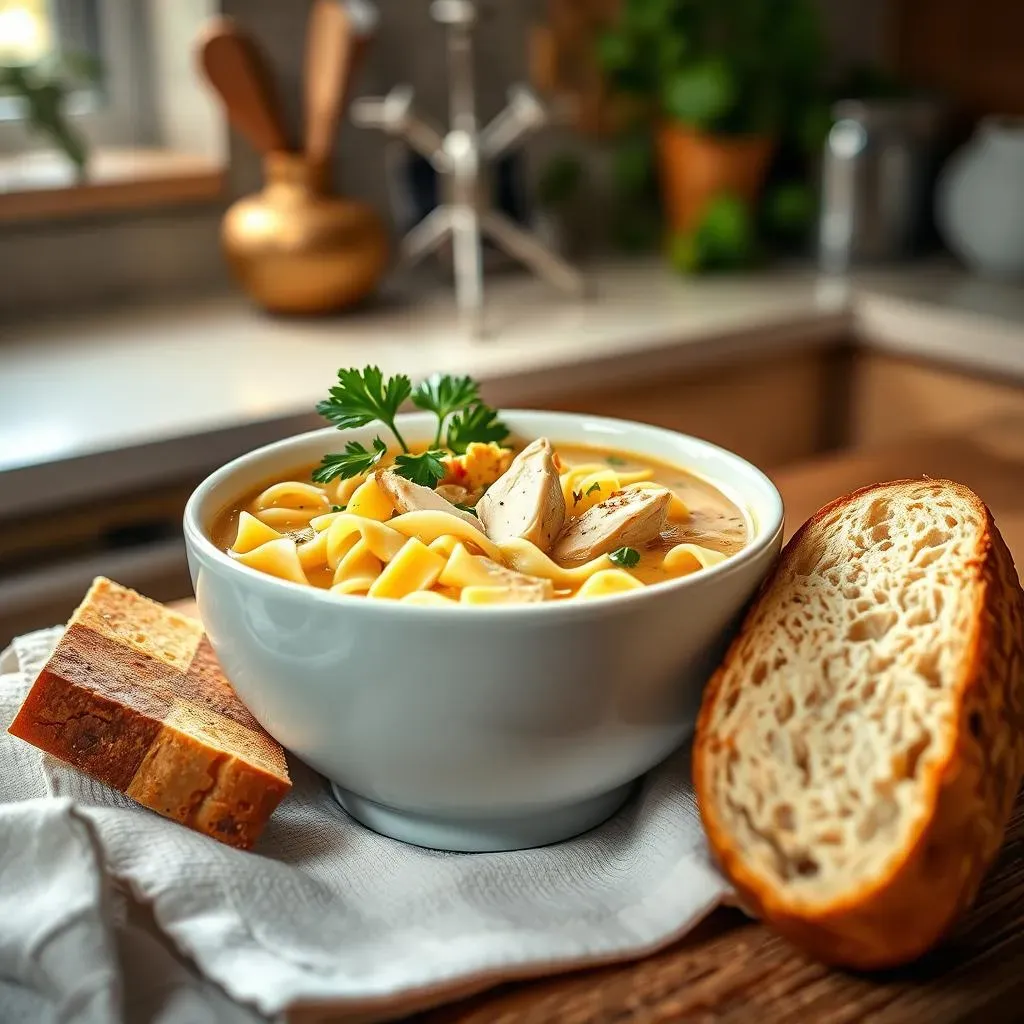
StepbyStep: Crafting Your Classic Chicken Noodle Soup
Sautéing the Veggies
Alright, let's get cooking! First, melt some butter (or olive oil if you're feeling fancy) in a large pot or Dutch oven over medium heat. Add your diced onions, carrots, and celery, and sauté them until they're softened and fragrant – about 5-7 minutes. This step is crucial because it builds the flavor base of your soup. Don't rush it! You want those veggies to release their natural sweetness and aromas. And hey, if you're feeling a little extra, throw in a clove or two of minced garlic during the last minute of sautéing. Just be careful not to burn the garlic, or it'll turn bitter.
Building the Broth
Now comes the broth! Pour in your chicken broth (homemade or store-bought) and bring it to a simmer. If you used a rotisserie chicken carcass to make your own broth, now's the time to strain it through a fine-mesh sieve to remove any bones, skin, or vegetable bits. Return the strained broth to the pot and add your shredded chicken, herbs (parsley, thyme, bay leaf), and any other veggies you're using. Season with salt and pepper to taste. Remember, you can always add more seasoning later, so it's better to start with less and adjust as you go.
Noodle Time!
Once your soup is simmering and the flavors are melding together, it's time to add the noodles. If you're using homemade egg noodles, cook them separately in boiling water according to the recipe instructions. This will prevent them from making your soup cloudy and gummy. If you're using store-bought noodles, add them directly to the soup pot and cook until they're tender – usually about 8-10 minutes. Be careful not to overcook the noodles, or they'll turn to mush.
Once the noodles are cooked, give the soup a final taste and adjust the seasoning as needed. Remove the bay leaf before serving. And that's it! Your classic chicken noodle soup is ready to be enjoyed. Serve it hot with a sprinkle of fresh parsley and a side of crusty bread for dipping. Bon appétit!
Step | Description | Why It's Important |
|---|---|---|
Sautéing Veggies | Cook onions, carrots, celery in butter/oil | Builds flavor base |
Building the Broth | Add broth, chicken, herbs, seasoning | Creates the soup's body and flavor |
Noodle Time | Cook noodles separately or in the soup | Completes the soup with texture and substance |
Tips & Variations for the Perfect Chicken Noodle Soup Recipe

Tips & Variations for the Perfect Chicken Noodle Soup Recipe
Spice It Up!
Alright, so you've got the basic recipe down. Now let's talk about kicking things up a notch! Don't be afraid to experiment with different flavors and ingredients to make it your own. A pinch of red pepper flakes can add a subtle kick, while a squeeze of lemon juice brightens up the broth. I've even added a dash of hot sauce before – trust me, it's delicious! For a more exotic twist, try adding a little ginger and lemongrass for an Asian-inspired flavor. The possibilities are endless!
Another way to add flavor is to use different types of broth. Turkey broth, vegetable broth, or even beef broth can all work well, depending on your preference. Just be sure to adjust the seasoning accordingly. And if you're feeling adventurous, try roasting your vegetables before adding them to the soup. This will intensify their flavor and add a lovely smoky note. For a richer flavor, try using bone broth as the base. It's packed with nutrients and collagen, which is great for your joints and skin.
Noodle Nirvana & Beyond
Let's talk noodles! While egg noodles are the classic choice, there are so many other options to explore. For a heartier soup, try using wide egg noodles, rotini, or even ditalini. If you're gluten-free, there are plenty of gluten-free noodles available, like rice noodles, quinoa noodles, or even zucchini noodles. Just be sure to cook them according to the package instructions to avoid them becoming mushy.
And don't forget about other add-ins! A handful of chopped spinach or kale adds a boost of nutrients and color. Diced potatoes or sweet potatoes make the soup heartier and more filling. And for a truly indulgent treat, try adding a dollop of sour cream or crème fraîche to each bowl before serving. It adds a lovely tanginess and richness that's simply irresistible. Also, consider adding a protein like shredded turkey, diced ham, or even chickpeas for a vegetarian option.
Variation | Description | Flavor Profile |
|---|---|---|
Spicy Chicken Noodle | Add red pepper flakes, hot sauce | Warm, Spicy |
Lemon Chicken Noodle | Squeeze of lemon juice | Bright, Tangy |
Asian-Inspired | Ginger, Lemongrass | Exotic, Aromatic |
Vegetarian | Add chickpeas, omit chicken | Hearty, Plant-Based |
Making Ahead & Storing Your Homemade Chicken Noodle Soup
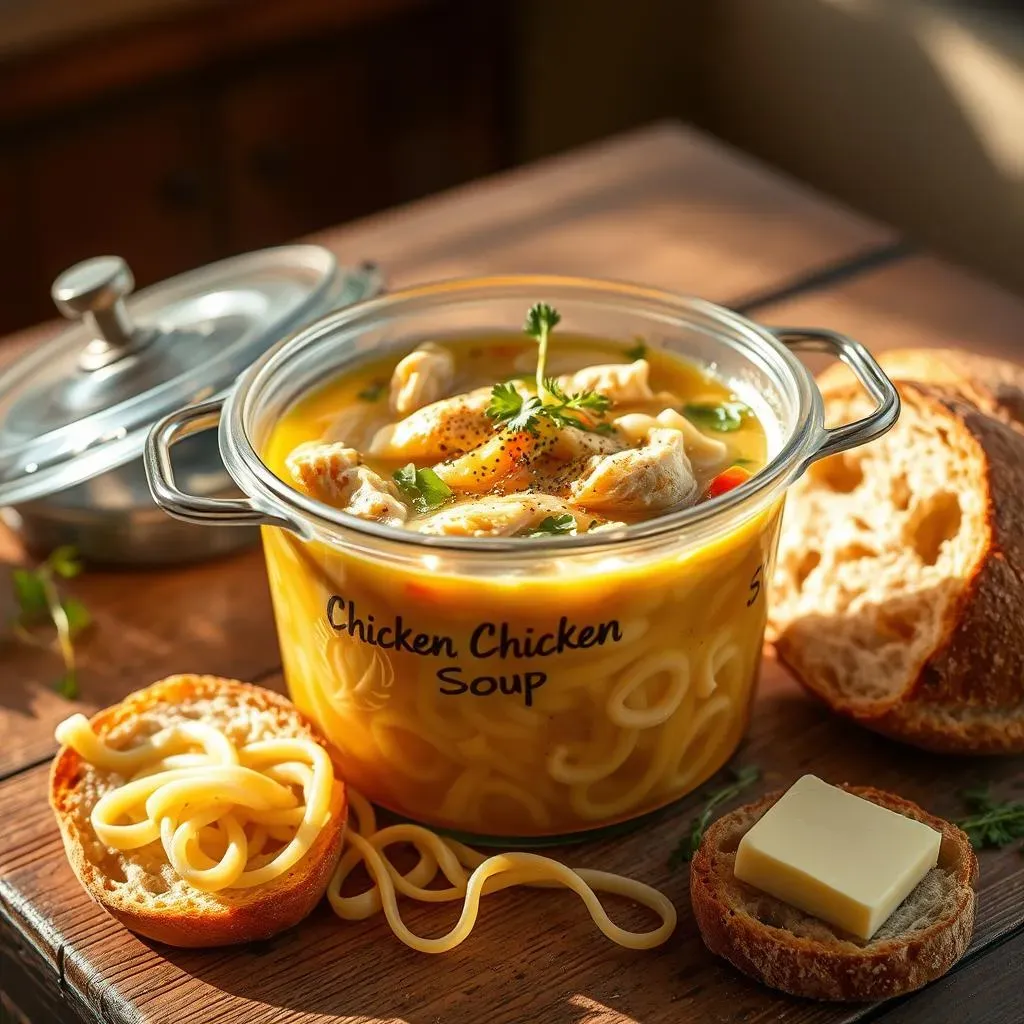
Making Ahead & Storing Your Homemade Chicken Noodle Soup
Making Ahead: A Soup Saver
Life gets hectic, right? That's where making your chicken noodle soup ahead of time comes in clutch. The beauty of this soup is that it actually tastes even better the next day, as the flavors have more time to meld together. If you're planning to make it ahead, I recommend preparing the soup up to the point of adding the noodles. Cook the noodles separately right before serving to prevent them from getting soggy and absorbing all the broth. Let the soup cool completely before storing it in an airtight container in the refrigerator for up to 3-4 days.
When you're ready to serve, simply reheat the soup over medium heat until it's warmed through. Then, cook your noodles separately, add them to the soup, and simmer for a few minutes until they're tender. Boom! Freshly made soup with minimal effort. This is a total game-changer for busy weeknights or when you have unexpected guests.
Freezing for Future Comfort
Want to keep that comfort on hand for even longer? Freezing is your best friend. But here's a pro tip: noodles don't freeze well. They tend to get mushy and lose their texture when thawed. So, if you're planning to freeze your soup, it's best to leave the noodles out altogether. Prepare the soup as usual, let it cool completely, and then transfer it to freezer-safe containers or zip-top bags. Be sure to leave some headspace in the containers, as the soup will expand as it freezes. Label and date the containers, and freeze for up to 2-3 months.
When you're ready to enjoy your frozen soup, thaw it in the refrigerator overnight or in a pot over low heat. Once it's thawed, bring it to a simmer, add your freshly cooked noodles, and cook until they're tender. Taste and adjust the seasoning as needed. And there you have it – a comforting bowl of homemade chicken noodle soup, ready to warm you up on a chilly day. It’s like having a little bit of sunshine stored away for a rainy day!
Storage Method | Instructions | Noodle Recommendation |
|---|---|---|
Refrigerating (3-4 days) | Cool completely, store in airtight container | Cook noodles separately before serving |
Freezing (2-3 months) | Leave out noodles, cool completely, store in freezer-safe container | Add freshly cooked noodles after thawing and reheating |
Nutritional Information: Classic Chicken Noodle Soup, a Healthy Choice?
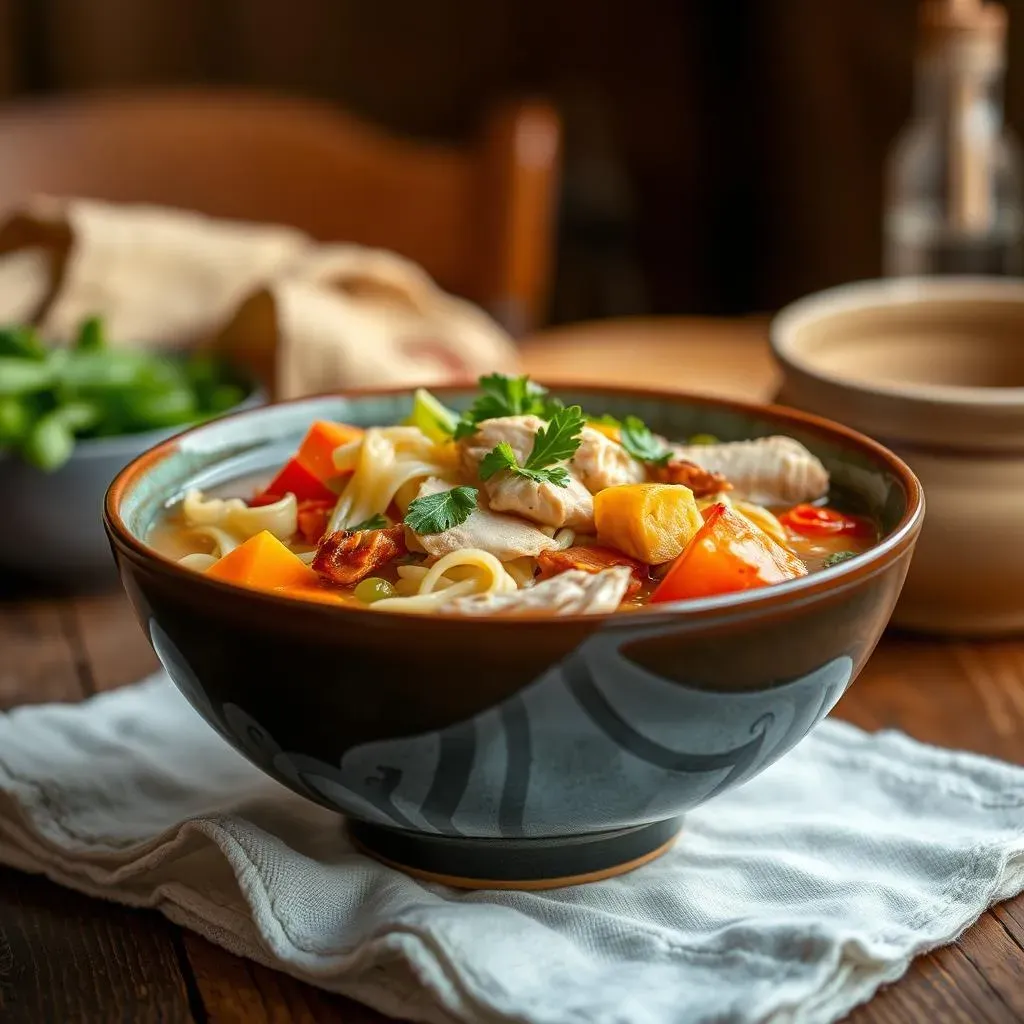
Nutritional Information: Classic Chicken Noodle Soup, a Healthy Choice?
A Bowlful of Goodness
So, is classic chicken noodle soup actually good for you? The answer is a resounding yes, with a few caveats. When made with wholesome ingredients, it can be a nutritional powerhouse. The broth is hydrating and packed with electrolytes, which is especially helpful when you're feeling under the weather. Chicken provides lean protein, essential for muscle repair and immune function. And the veggies? They're loaded with vitamins, minerals, and antioxidants that support overall health.
However, the nutritional value can vary depending on the ingredients and preparation method. Store-bought soups can be high in sodium and preservatives, so it's always best to make your own. By controlling the ingredients, you can ensure that your soup is both delicious and nutritious. For instance, using low-sodium broth and adding plenty of fresh vegetables can significantly boost the health benefits.
Macro Breakdown & Calorie Count
Let's break down the macros and calorie count. A typical serving (about 1.5 cups) of homemade chicken noodle soup contains roughly 150-200 calories, 10-15 grams of protein, 20-25 grams of carbohydrates, and 5-10 grams of fat. Of course, these numbers can vary depending on the specific ingredients you use. For example, using more chicken will increase the protein content, while adding more noodles will increase the carbohydrate content. The fat content will depend on whether you use butter or oil to sauté the vegetables and the type of chicken you use.
To make your soup even healthier, consider using whole-wheat noodles or adding more vegetables. You can also reduce the sodium content by using low-sodium broth and limiting the amount of salt you add. And if you're watching your fat intake, you can use skinless chicken breasts or thighs and trim any excess fat before cooking. Ultimately, chicken noodle soup can be a very healthy and satisfying meal. It's all about making smart choices and customizing the recipe to fit your individual needs and preferences.
Nutrient | Approximate Amount per Serving (1.5 cups) | Benefit |
|---|---|---|
Calories | 150-200 | Energy |
Protein | 10-15 grams | Muscle Repair, Immune Function |
Carbohydrates | 20-25 grams | Energy |
Fat | 5-10 grams | Satiety, Nutrient Absorption |
The Last Sip: Enjoying Your Classic Chicken Noodle Soup
And there you have it – a steaming bowl of classic chicken noodle soup, crafted with love and ready to nourish. From simmering the perfect broth to adding your own personal touch with variations, this recipe is a foundation to build upon. Whether you're battling a cold, seeking comfort on a chilly day, or simply craving a taste of home, this soup is sure to hit the spot. So, ladle up a generous portion, grab a spoon, and savor the simple pleasure of homemade goodness. Happy cooking!
